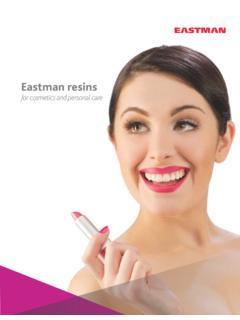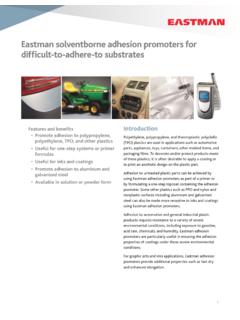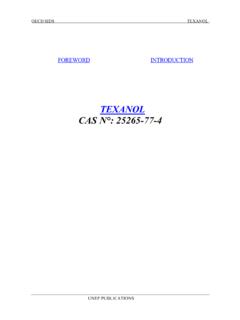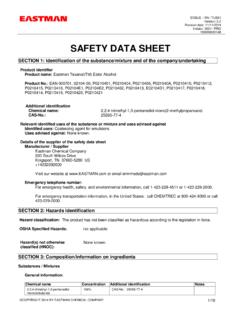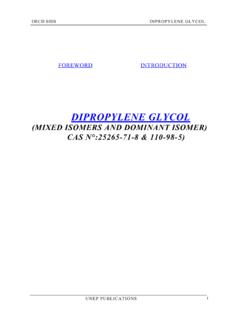Transcription of Properties and uses - eastman.com
1 Properties and uses Contents 1 Overview 1 uses 1 Technical support for specific applications 2 Properties 2 Chemistry 6 Product types 6 Butvar: the right resin solution 13 Compatibility 15 Insolubilizing reactions 17 Applications 17 Wire enamels 17 Surface coatings 17 Wash primers 17 Military-specification wash primers 18 Nonspecification wash primers: B-1030 with Butvar 18 Single-package wash primer: B-1011 with Butvar 19 Chromate-free wash primers with Butvar 20 Metal coatings 21 Wood finishes 21 Protective wash coats and sealers 21 Knot sealers 22 Adhesives 22 Structural adhesives 22 Phenolic resins 22 Epoxies and other thermosetting resins 23 High-strength bonding procedure 23 Performance characteristics 23 Adhesive strengths 24 Hot-melt adhesives 24 Textile coatings 24 Advantages as textile coating 25 Ceramic binder applications 26 Tape casting 26 Thick films 27 Toners and printing inks 28 Storage and handling 28 Storage 28 Toxicity and FDA status 28 Quality control 29 Material sources1 Overview Polyvinyl butyral resins are employed in a wide array of industrial and commercial applications.
2 These unique resins offer impressive performance as well as outstanding versatility. Butvar polyvinyl butyral resins have a combination of Properties that make them key ingredients in a variety of successful formulations. Some of the Properties for which Butvar is widely used are outstanding binding efficiency, optical clarity, adhesion to a large number of surfaces, and toughness combined with flexibility. eastman offers six grades of Butvar resins that cover a broad range of chemical and physical Properties . These resins are generally well suited either as a major ingredient of a formulation or, in smaller quantities, to enhance the Properties of other Some of the applications in which Butvar is a vital ingredient include: Ceramic binders Inks/dry toners Wood coatings Wash primers Composite fiber binders Structural adhesives Other diverse uses Technical support for specific applications eastman offers technical support for Butvar resins and can assist you in your specific application.
3 For more information regarding Butvar resins, to seek technical help, or to request a sample, visit ChemistryAcetals, such as polyvinyl butyral, are formed by the well-known reaction between aldehydes and alcohols. The addition of one molecule of an alcohol to one molecule of an aldehyde produces a hemiacetal. Hemiacetals are rarely isolated because of their inherent instability; instead, they are further reacted with another molecule of alcohol to form a stable acetal. Polyvinyl acetals are prepared from aldehydes and polyvinyl alcohols. Polyvinyl alcohols are high-molecular-weight resins containing various percentages of hydroxyl and acetate groups produced by hydrolysis of polyvinyl acetate. The conditions of the acetal reaction and the concentration of the particular aldehyde and polyvinyl alcohol used are closely controlled to form polymers containing predetermined proportions of hydroxyl, acetate, and acetal groups.
4 The final product may be represented by the following stylized structure. The proportions of A, B, and C are controlled, and they are randomly distributed along the molecule. H R C + R1 OHOA lcoholAldehydeH R C ( OR1)2 + H2 OAcetalHHC3H7 HCH2CH2 CCCOOPV butyralA H CH2 C OHPV alcoholB H CH2 C O C CH3 OPV acetateCH R C OR + R1 OH OHHemiacetalAlcohol3 Table 1. Physical Properties of Butvar resins (white, free-flowing powder) PropertyUnitsASTM methodB-72B-74B-76B-79B-90B-98 Volatiles,a max. % wt (weight average in thousands) (1)170 250120 15090 12050 8070 10040 70 Solution viscosity 15% by weightcP(2)7,000 14,0003,000 7,000500 1,000100 400600 1,200200 400 Solution viscosity 10% by weightcP(2)1,600 2,500800 1,300200 45075 200200 40075 200 Ostwalda solution viscositycP(3)170 gravity 23 /23 C ( ) index ( ) absorption (24 hours) % content expressed as % polyvinyl alcohol content expressed as % polyvinyl acetate 0 content expressed as % polyvinyl butyral, approx.
5 808088888080aSpecification propertiesAll Properties were determined by ASTM methods except the following:(1) Molecular weight was determined via size-exclusion chromatography with low-angle laser light scattering (SEC/LALLS) method of Cotts and Ouano in (2) Solution viscosity was determined in 15%-by-weight solutions in 60:40 toluene/ethanol at 25 C using a Brookfield Viscometer and in 10% solution in 95% ethanol @ 25 C using an Ostwald-Cannon-Fenske Viscometer. (3) Ostwald solution viscosity for each product type measured with an Ostwald-Cannon-Fenske Viscometer. The solvents and solids levels used are as follows: Product% solidsSolventTemperature ( C)B-727. 5 Anhydrous methanol20B-76, 29 ethyl alcohol25B-74, B-90, methanol20b P. Dublin, ed., Microdomains In Polymer Solutions (New York: Plenum Press, 1985), pp. 2. Chemical Properties of Butvar resins PropertyUnitsASTM methodB-72B-74B-76B-79B-90B-98 Resistance to Weak acids D543-56 TEEEEEE Strong acids D543-56 TEEEEEE Weak bases D543-56 TEEEEEE Strong bases D543-56 TEEEEEEO rganic solvents Alcohols D543-56 TPPPPPP Chlorinated D543-56 TGGFFGG Aliphatic D543-56 TEEFFEE Aromatic D543-56 TFFPPFF Esters D543-56 TFFPPFF Ketones D543-56 TFFPPFFKey: E excellent G good F fair P poorTable 3.
6 Mechanical Properties of Butvar resins PropertyUnitsASTM methodB-72B-74B-76B-79B-90B-98 Tensile strength Yield103 Break103 Yield%D638-58T888888 Break%D638-58T7075110110100110 Modulus of elasticity (apparent)105 strength, yield103 psiD790-59T12 1312 1211 12 Hardness, Rockwell M D785-51115115100100115110 E D785-512020552020 Impact strength Izod, notched x .11 . *Specification properties5 Table 4. Thermal Properties of Butvar resins PropertyUnitsASTM methodB-72B-74B-76B-79B-90B-98 Flow temperature, 1,000 psi CD569-59145 155135 145110 115110 115125 130105 110 Glass transition temperature (Tg) C(1)72 7872 7862 7262 7272 7872 78 Ash content at 550 C In nitrogen%(2)< < < < < < In air%(2)< < < < < < distortion temperature CD648-5656 6056 6050 5450 5452 5645 55 Heat-sealing temperature F(3)220220200200205200(1) Glass transition temperature (Tg) was determined by differential scanning calorimeter (DSC) over a range of 30 100 C on dried granular resin.
7 (2) Ash content of the thermal gravimetric analysis (TGA) was determined as a weight loss versus temperature profile conducted at a heating rate of 10 C/min.(3) Heat-sealing temperature was determined on a 1-mil dried film on paper cast from a 10% solution in 60:40 toluene/ ethanol. A dwell time of sec at a 60-psi line pressure was used on the heat 5. Electrical Properties of Butvar resins PropertyUnitsASTM methodB-72B-74B-76B-79B-90B-98 Dielectric constant 50 cP 10 cP 10 cP 10 cP factor 50 cP 10 cP 10 cP 10 cP < strength (1/8-in. thickness) Short timeV/milD149-59420420480480450400 Step by stepV/milD149-594004003903903703806 Product types The Properties of the various types of Butvar resins are described in Tables 1 through 5. The resins are offered in a variety of molecular weight ranges and viscosities. B-76 and B-79 have lower hydroxyl content than the other Butvar resins.
8 This permits broader solubility characteristics. As a general rule, the substitution of butyral groups for acetate groups results in a more hydrophobic polymer with a higher heat distortion temperature. At the same time, the polymer s toughness and adhesion to various substrates is considerably increased. The outstanding adhesion of the polyvinyl butyral resins is a result of their terpolymer constitution. Because each molecule presents the choice of three different functional groups to a surface, the probability of adhesion to a wide variety of substrates is increased substantially. Although polyvinyl butyral resins normally are thermoplastic and soluble in a range of solvents, they may be cross-linked through heating and with a trace of mineral acid. Cross-linking is generally caused by transacetalization but also may involve more complex mechanisms, such as a reaction between acetate or hydroxyl groups on adjacent chains.
9 As a practical matter, cross-linking of the polyvinyl butyrals is carried out by reaction with various thermosetting resins, such as phenolics, epoxies, ureas, diisocyanates, and melamines. The availability of the functional hydroxyl groups in Butvar resins for condensations of this kind is an important consideration in many applications. Incorporation of even a small amount of Butvar resin into thermosetting compositions will markedly improve toughness, flexibility, and adhesion of the cured coating. Polyvinyl butyral films are characterized by high resistance to aliphatic hydrocarbons and mineral, animal, and vegetable oils (with the exception of castor and blown oils). They withstand strong alkalis but are subject to some attack by strong acids. However, when employed as components of cured coatings, their stability to acids as well as solvents and other chemicals is improved greatly. Butvar will withstand heating up to 200 F for prolonged periods with little : the right resin solutions Butvar resins generally are soluble in alcohols, glycol ethers, and certain mixtures of polar and nonpolar solvents.
10 A representative list of Butvar solvents can be found in Table 6. In general, Butvar B-98 resin will show the same compatibility characteristics as B-90 and, therefore, should prove advantageous where physical and chemical Properties of B-90 are desired but lower solution viscosities are necessary. The same is true for Butvar B-79 in relation to B-76. When an alcohol is the only solvent, the viscosity of a Butvar solution increases as the molecular weight of the alcohol increases. Blends of alcohols with aromatic solvents provide the best starting point for the development of solvent systems. Where alcohols, such as ethyl or isopropyl, are employed either alone or in a mixture with other solvents, use the 95% grades. The presence of water gives lower solution viscosities than solutions utilizing anhydrous alcohols. Butvar solutions show very marked viscosity increases as resin solids increase. This effect is shown in Graphs 3 through 10.
